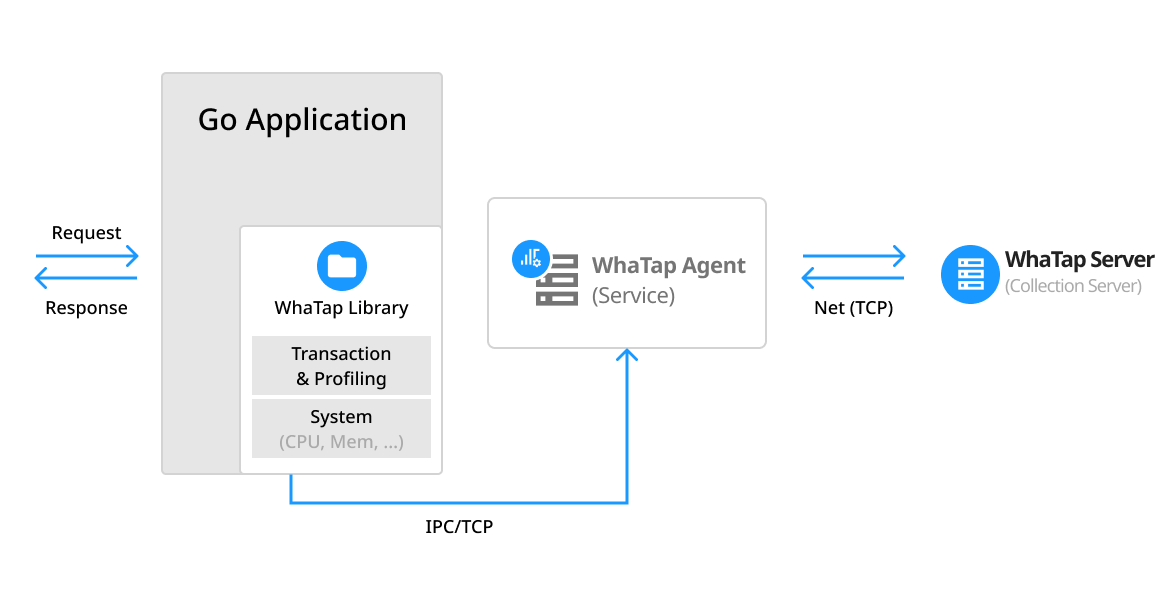WhaTap Go Application Monitoring provides the monitoring service for the Go applications.
- It supports the web framework. It collects the data such as web transaction URL, response time, TPS information, error message, etc.
- It continuously collects data from the Go Runtime package. It also collects data including memory, goroutine, and GC related data.
- When multiple API/RPC services are called in the MSA environment, the call relationships are collected through link tracing.
WhaTap's Application Monitoring can monitor application in real time without reproducing failures.
Add the github.com/whatap/go-api package to the Go application source code.
go get github.com/whatap/go-api@latest
Configure for initialization and shutdown with the trace.Init() and trace.Shutdown() functions. Set the startup and end for transactions with the trace.Start() and trace.End() functions.
import (
"github.com/whatap/go-api/trace"
)
func main(){
trace.Init(nil)
//It must be executed before closing the app.
defer trace.Shutdown()
...
}
An agent must be installed on the same server to forward data from the monitored application server through TCP communication and to transfer the data to the WhaTap collection server. The agent can be installed using the package.
Note The agent works as the default 127.0.0.1:6600 TCP server. It receives data from the Go application and forwards the data to the WhaTap collection server via the outbound 6600 port.
1 Install the WhaTap repository. 2 Install the whatap-agent Linux package (yum, apt-get). 3 Run the whatap-agent service.
$ sudo rpm -Uvh http://repo.whatap.io/centos/5/noarch/whatap-repo-1.0-1.noarch.rpm
$ sudo yum install whatap-agent
$ wget http://repo.whatap.io/debian/release.gpg -O -|sudo apt-key add -
$ wget http://repo.whatap.io/debian/whatap-repo_1.0_all.deb
$ sudo dpkg -i whatap-repo_1.0_all.deb
$ sudo apt-get update
$ sudo apt-get install whatap-agent
$ sudo rpm --import http://repo.whatap.io/centos/release.gpg
$ echo "[whatap]" | sudo tee /etc/yum.repos.d/whatap.repo > /dev/null
$ echo "name=whatap packages for enterprise linux" | sudo tee -a /etc/yum.repos.d/whatap.repo > /dev/null
$ echo "baseurl=http://repo.whatap.io/centos/latest/\$basearch" | sudo tee -a /etc/yum.repos.d/whatap.repo > /dev/null
$ echo "enabled=1" | sudo tee -a /etc/yum.repos.d/whatap.repo > /dev/null
$ echo "gpgcheck=0" | sudo tee -a /etc/yum.repos.d/whatap.repo > /dev/null
$ sudo yum install whatap-agent
[whatap-agent.tar.gz]After downloading the file (https://s3.ap-northeast-2.amazonaws.com/repo.whatap.io/alpine/x86_64/whatap-agent.tar.gz), unzip the file based on the "/" directory. Create the monitoring file in the /usr/whatap/agent path.
$ wget https://s3.ap-northeast-2.amazonaws.com/repo.whatap.io/alpine/x86_64/whatap-agent.tar.gz
$ tar -xvzf whatap-agent.tar.gz -C /
FROM golang:1.20
# install whatap-agent (x64)
RUN wget https://s3.ap-northeast-2.amazonaws.com/repo.whatap.io/alpine/x86_64/whatap-agent.tar.gz
RUN tar -xvzf whatap-agent.tar.gz -C /
# Create whatap.conf. You can copy it or attach it as a volume.
RUN echo "accesskey=aaasd-23432-123-" >> /app/whatap.conf
RUN echo "whatap.server.host=1.1.1.1/2.2.2.2" >> /app/whatap.conf
# Whatap/go-api library must be imported into the user application.
WORKDIR /app
ENV WHATAP_HOME /app
RUN go mod tidy
RUN go mod download -x
RUN go build -o ./app app.go
# Run whatap-agent and the user application together with the Docker execution command.
CMD ['sh', '-c', '/usr/whatap/agent/whatap-agent start && /app/app']
Default settings Execute the following commands in order to set the access key and collection server IP in whatap.conf.
- Create the whatap.conf file in the path of the application startup script.
- If the WHATAP_HOME environment variable has not been set, the path of the application startup script is recognized as the one of the whatap.conf file.
# Creation of whatap.conf in the script running path
$ echo "license={Access Key}" >> ./whatap.conf
$ echo "whatap.server.host={Collection Server IP}" >> ./whatap.conf
$ echo "app_name={Application Name}" >> ./whatap.conf
# Run application
./app
- license: Enter the access key.
- whatap.server.host: Enter the collection server IP address.
- app_name: Enter the application name. Set the user as a string.
Note app_name is a component to determine the agent name. For more information, see the following.
You can set the whatap.conf path as the WHATAP_HOME variable. Create the WHATAP_HOME path first.
# Set the whatap.conf path after setting the WHATAP_HOME path.
mkdir ./whatap_home
echo "license={Access Key}" >> ./whatap_home/whatap.conf
echo "whatap.server.host={Collection Server IP}" >> ./whatap_home/whatap.conf
echo "app_name={Application Name}" >> ./whatap_home/whatap.conf
# Run the application.
WHATAP_HOME=./whatap_home ./app
If one whatap.conf file is shared by the applications running in multiple processes, any changes may not be reflected. It is recommended to set a whatap.conf for each process.
To avoid duplicate agent names, you can add a string to each agent name for identification. The value set with the app_name option is added to the beginning of the agent name.
You can avoid duplicate names of agents run with the same command and the same instance.
# Set the whatap.conf path after setting the WHATAP_HOME path.
mkdir ./whatap_home
echo "license={Access Key}" >> ./whatap_home/whatap.conf
echo "whatap.server.host={Collection Server IP}" >> ./whatap_home/whatap.conf
echo "app_name={Application Name-1}" >> ./whatap_home/whatap.conf
# Run the application.
WHATAP_HOME=./whatap_home ./app
# Set the whatap.conf path after setting the WHATAP_HOME path.
mkdir ./whatap_home1
echo "license={Access Key}" >> ./whatap_home1/whatap.conf
echo "whatap.server.host={Collection Server IP}" >> ./whatap_home1/whatap.conf
echo "app_name={Application Name-2}" >> ./whatap_home1/whatap.conf
# Run the application
WHATAP_HOME=./whatap_home1 ./app
